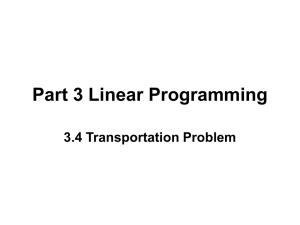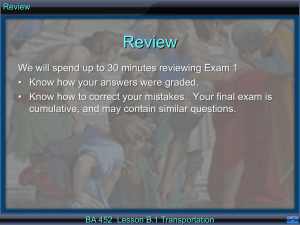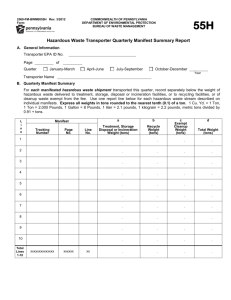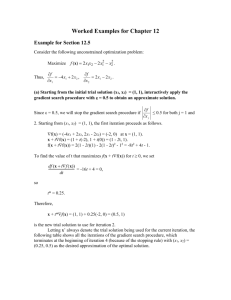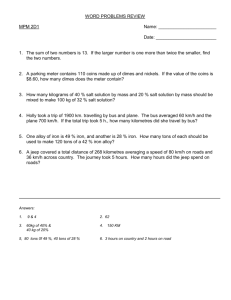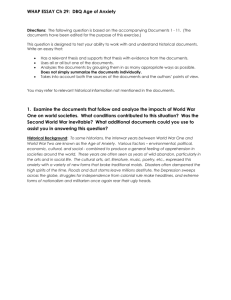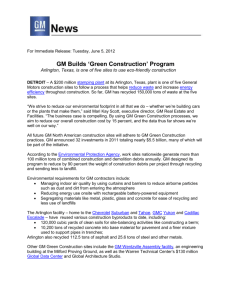LP11PROB
advertisement
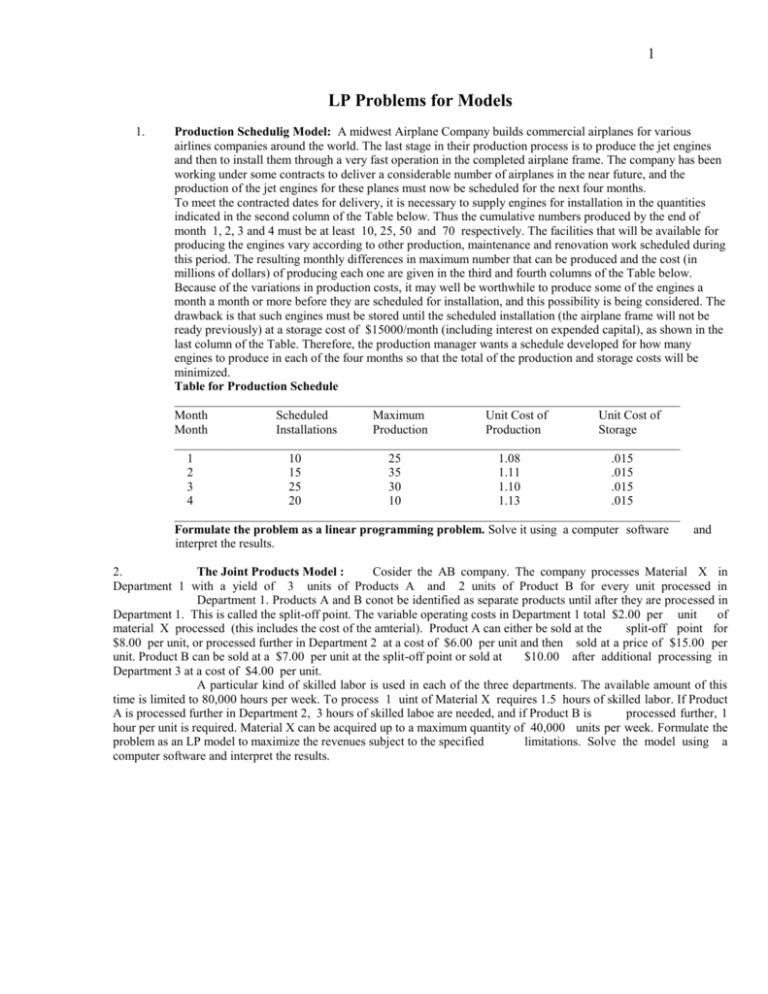
1 LP Problems for Models 1. Production Schedulig Model: A midwest Airplane Company builds commercial airplanes for various airlines companies around the world. The last stage in their production process is to produce the jet engines and then to install them through a very fast operation in the completed airplane frame. The company has been working under some contracts to deliver a considerable number of airplanes in the near future, and the production of the jet engines for these planes must now be scheduled for the next four months. To meet the contracted dates for delivery, it is necessary to supply engines for installation in the quantities indicated in the second column of the Table below. Thus the cumulative numbers produced by the end of month 1, 2, 3 and 4 must be at least 10, 25, 50 and 70 respectively. The facilities that will be available for producing the engines vary according to other production, maintenance and renovation work scheduled during this period. The resulting monthly differences in maximum number that can be produced and the cost (in millions of dollars) of producing each one are given in the third and fourth columns of the Table below. Because of the variations in production costs, it may well be worthwhile to produce some of the engines a month a month or more before they are scheduled for installation, and this possibility is being considered. The drawback is that such engines must be stored until the scheduled installation (the airplane frame will not be ready previously) at a storage cost of $15000/month (including interest on expended capital), as shown in the last column of the Table. Therefore, the production manager wants a schedule developed for how many engines to produce in each of the four months so that the total of the production and storage costs will be minimized. Table for Production Schedule ________________________________________________________________________________ Month Scheduled Maximum Unit Cost of Unit Cost of Month Installations Production Production Storage ________________________________________________________________________________ 1 10 25 1.08 .015 2 15 35 1.11 .015 3 25 30 1.10 .015 4 20 10 1.13 .015 ________________________________________________________________________________ Formulate the problem as a linear programming problem. Solve it using a computer software and interpret the results. 2. The Joint Products Model : Cosider the AB company. The company processes Material X in Department 1 with a yield of 3 units of Products A and 2 units of Product B for every unit processed in Department 1. Products A and B conot be identified as separate products until after they are processed in Department 1. This is called the split-off point. The variable operating costs in Department 1 total $2.00 per unit of material X processed (this includes the cost of the amterial). Product A can either be sold at the split-off point for $8.00 per unit, or processed further in Department 2 at a cost of $6.00 per unit and then sold at a price of $15.00 per unit. Product B can be sold at a $7.00 per unit at the split-off point or sold at $10.00 after additional processing in Department 3 at a cost of $4.00 per unit. A particular kind of skilled labor is used in each of the three departments. The available amount of this time is limited to 80,000 hours per week. To process 1 uint of Material X requires 1.5 hours of skilled labor. If Product A is processed further in Department 2, 3 hours of skilled laboe are needed, and if Product B is processed further, 1 hour per unit is required. Material X can be acquired up to a maximum quantity of 40,000 units per week. Formulate the problem as an LP model to maximize the revenues subject to the specified limitations. Solve the model using a computer software and interpret the results. 2 3. Gasoline Blending Model: One of the oil companies named as GOC. The GOC produces regular, premium and low-lead gasoline by blending three constituents type 1, 2, and 3. The three constituents are available in limited quantities and costs as follows: constituent Maximum Available / Day Cost / Barrel (Barrels)________________________________________ Type 1 2,000 $10.00 Type 2 3,000 7.50 Type 3 1,000 5.00 __________________________________________________________________________________________ The selling prices are $0.20 per gallon (there are 50 gallons in a barrel) for regular, $0.30 for premium, and $0.15 for low-lead gasoline. The low-lead market is limited to 5,000 gallons per day. The gasoline must be produced according to the following specifications. Regular: 1. Not less than 20% of constituent of Type 1. 2. Not more than 30% of constituent of Type 3. Premium: 1. Not less than 40% of constituent of Type 1. 2. Not less than 10% and not more than 20% of constituent of Type 2. 3. Not more than 10% of constituent of Type 3. Low-Lead: 1. Not less than 30% of constituent of Type 2. Formulate the problem as a Linear Programming problem so as to determine the volume of each gasoline to sell that will maximize profits. Solve the model using a computer software and interpret the results. 4. Coffee Blending Model: A coffee manufacturer blends four component coffee beans into three final blends of coffee. The Table below summarizes the very precise recipes for the final coffee blends, the cost and availability information for the four components, and the wholesale price per pound of the final blends. The percentages in the body of the table indicate the percentage of each component to be used in each blend. Table: Percentage of each component to be used in each blend _______________________________________________________________________________________ Cost Per Maximum Availability Component 1 2 3 Pound Each Week (Pound) _____________________________________________________________________________________ 1 20 35 10 $0.60 40,000 2 40 15 35 $0.80 25,000 3 15 20 40 $0.55 20,000 4 25 30 15 $0.70 45,000 _______________________________________________________________________________________ Wholesale Price/lb. $1.25 $1.50 $1.40 _______________________________________________________________________________________ Weekly capacity for the processor's plant is 100,000 pounds, and the company wishes to operate at capacity. There is no problem in selling the final blends, although there is a requirement that minimum production level of 10,000, 25,000 and 30,000 pounds, respectively, be met for blends 1, 2 and 3. The manufacturer wishes to determine the number of pounds of each component which should be used in each blend so as to maximize total weekly profit. Formulate the problem as an L.P. model. Solve the model using a computer software and interpret the results. 5. Multi-period Investment Problem. The Winnipeg Company has $200,000 available for investment in a series of opportunities. There is no limit on the amount that can be invested in any opportunity. Opportunity A is available in each of the next five years and can be repeated as many times as desired. Foe every dollar invested in A at the beginning of a year, $1.20 will be returned two years later. Similarly, opportunity B is available in each of the 5 years and, after 3 years, will return $1.30 for every dollar invested at the beginning of a year. The other opportunities are available only once. Opportunity C will return, at the beginning of the fifth year, $1.40 per dollar invested. But opportunity C is available only at the beginning of the first year. Opportunity D, available at the beginning of the second year will return $1.70 at the end of the fifth year per dollar invested. 3 Opportunity E is available at the beginning of the fourth year and will, in one year, return $1.40 per dollar invested. The company wishes to determine an investment scheme that allows the $200,000 to grow by the greatest amount during the 5year period. Any realized gains on the $200,000 can also be invested. Formulate a linear programming model that will fulfill company's wishes. Solve it using a computer software and interpret the results. 6. 7. Caterer's Problem. Suppose a caterer must supply clean napkins in the amounts 1,000; 700; 800; 1,200 and 1,500 for the next five days, respectively. The caterer has three alternatives for supplying napkins on any given day: (i) Purchase new napkins at a cost of $1.00 each. (ii) Utilize previously soiled napkins which have been cleaned by 1day (next day) service at a cost of $0.20 each. (iii) Utilize previously soiled napkins which have been cleaned by a 2day service at a cost of $0.10 each. Formulate an LP model for minimizing the total cost of supply. Solve the model using a computer software and interpret the results. City 1 produces 500 tons of waste per day, and city 2 produces 400 tons of waste per day. Waste must be incinerated at incinerator 1 or incinerator 2, and each incinerator can process up to 500 tons of waste per day. The cost to incinerate waste is $40/ton at incinerator 1 and $30/ton at incinerator 2. Incineration reduces each ton of waste to 0.2 tons of debris, which must be dumped at one of two landfills. Each landfill can receive at most 200 tons of debris per day. It costs $3 per mile to transport a ton of material (either debris or waste). Distances (in miles) between locations are shown in Table below. Formulate an LP that can be used to minimize the total cost of disposing off the waste of both cities. TABLE ________________________________________________________________________ INCIN. 1 INCIN. 2 ________________________________________________________________________ City 1 30 5 City 2 36 42 ________________________________________________________________________ LANDFILL 1 LANDFILL 2 _____________ Incin. 1 5 8 Incin. 2 9 6 ________________________________________________________________________ 8. A post office requires different numbers of full-time employees on different days of the week. The number of full-time employees required on each day is given in the table below. Table : Number of Employees Requirements ___________________________________________________________________________ Day 1(Mon) Day 2(Tue) Day 3(Wed) Day 4(Thu) Day 5(Fri) Day 6(Sat) Day 7(Sun) 17 13 15 19 14 16 11 ___________________________________________________________________________ 4 Union rules state that each full time employee must work five consecutive days and then receive two days off. For example, an employee who works Monday through Friday must be off on Saturday and Sunday. The post office wants to meet its daily requirements using only full-time employees. Formulate an LP model of the problem that the post office can use to minimize the number of full-time employees that must be hired. Solve the model using a computer software and interpret the results. 9 Hospital Administration: A local hospital administration is attempting to determine a work schedule for registered nurses (R.N.'s). The union contract specifies that nurses are to work a normal day of six hours. Nurses may work an additional three hours on an overtime work basis (at one and one half their hourly pay rate). R.N.'s are paid on an average of $12 per hour. The administrator has determined a daily work schedule in which the day is divided into eight three-hour shifts. The table below indicates the estimated demand for nurses per shift. Period ____________________________________________________________________________________ 1 2 3 4 5 6 7 8 Shift 12369123693 A.M. 6 A.M. 9 A.M. 12 Noon 3 P.M. 6 P.M. 9 P.M. 12 Midnight Estimated number of required R.N.'s 30 20 50 60 70 60 50 40 _____________________________________________________________________________________ Nurses are to start work at the beginning of one of these shifts and end work at the end of the following shift: that is, unless they receive overtime. The contract specifies that (i) any nurses requested to work overtime will receive full payment for three hours of overtime, even if they work less than three hours. Thus, the administrator concludes that overtime, when assigned, should be for the maximum of three hours. The contract also specifies that, on the average, at least 10 % of all nurses can expect overtime assignments. Let x t be the number of nurses reporting to work at the beginning of period t who do not get overtime work and yt equal the number of nurses reporting to work in period t who do work overtime. Formulate the problem as an LP model which will allow the administrator to determine an assignment schedule which meets the shift requirements and contract specifications at a minimum cost. Solve the model using a computer software and interpret the results. 10. B.C. Wood Corporation (BSC) produces a special-purpose wood used in the housing and construction industries. The sales department of BSC has received orders of 2400, 2200, 2700, and 2500 tons of wood for each of the next 4 months. BSC can meet these demands by producing the wood, by drawing from its inventory, or by using any combination of the two alternatives. The production costs per ton of wood during each of the next four months are projected to be $7400, $7500, $7600, and $7650. Because costs are rising each month, due to inflationary pressures, BSC might be better off producing more wood than it needs in a given month and storing the excess. Production capacity, though, cannot exceed 4000 tons in any one month. The monthly production is finished at the end of the month at which time the demand is met. Any remaining wood is then stored in inventory at a cost of #120 per ton for each month that it remains there. These data are summarized in the table below. Table: Data for Production Planning Problem of BSC ____________________________________________________________________ Month 1 2 3 4 ___________________________________________________________________________ Demand (Tons) 2400 2200 2700 2500 Production Cost ($/ton) 7400 7500 7600 7650 Inv. Cost($/ton/month) 120 120 120 120 ___________________________________________________________________________ 5 If the production level is increased from one month to the next, then the company incurs a cost of $50 per ton of increased production to cover the additional labor and/or overtime. Each ton of decreased production incurs a cost of $30 to cover the benefits of unused employees. The production during the previous month was 1800 tons, and the beginning inventory is 1000 tons. Inventory at the end of the fourth month must be at least 1550 to cover anticipated demand. Using linear programming formulate a production plan for BSC that minimizes the total costs over the next four months. 11. Tata Enterprises of India exports wood to customers in Eastern Europe, Canada and United States. Although demand varies from quarter to quarter, contracts specify in advance the exact quarterly requirements. By processing these contracts through the company's management information system (MIS), sales staff have determined that Tata must deliver 2.5, 4, 3, and 4.5 million tons of wood in the next four quarters. There are several ways to meet the requirements. One possibility is to "track" demand with production. Although this option enables Tata to carry no inventory, it creates employee turnover and training problems and leaves substantial unused capacity at times. Another approach is to produce wood at a constant rate and allow inventory to absorb the fluctuation in demand. Such an approach offers manufacturing efficiency, but it typically involves a large inventory investment. Between these two extremes is the moderate option of carrying some inventory while varying the production level somewhat. Past experience indicates that the moderate option works best in Tata's operations. Management now must determine the production and inventory levels that will minimize the costs of fulfilling the company's wood contracts. Currently, Tata has 500,000 tons of wood in stock, and the company is manufacturing wood at the rate of 3 million tons per quarter. By processing historical manufacturing data through the MIS, the operations manager has forecasted that production costs will be $100, $120, $90, and $ 110 per ton over the next four quarters. A similar MIS analysis of historical changeover (labor and facility adjustment) data has indicated that it will cost $12 per ton to increase and $3 per ton to decrease production from one quarter to the next. By processing historical purchasing, book keeping, and storage transactions through the MIS, the operations manager also has estimated that it will cost 5% of the unit production cost in a quarter to inventory wood for the corresponding quarter. Company accounting policy requires the operations manager to asses his cost on the end-of-quarter inventory. At the end of four quarters, Tata wants no more than 400,000 tons and no less than 100,000 tons in stock. Using linear programming formulate a production plan for Tata that minimizes the total costs over the next four periods. 6 1. Given (i) Planning Horizon : 4 Months (ii) The following Table for Production Schedule _______________________________________________________________ Unit Cost of Unit Cost of Scheduled Maximum Production Storage Month Installation Production (million $) (million $) _______________________________________________________________ 1 10 25 1.08 .015 2 15 35 1.11 .015 3 25 30 1.10 .015 4 20 10 1.13 .015 ________________________________________________________________ Decision Variables. Let xij = # of engines produced in month i for installation in month j, (i < j) (Therefore, for i > j, xij = 0) cij = unit production and storage cost associatedwith each unit of xij, (i < j) Thus we have the cost matrix Cij as follows. Month Produced 1 2 3 Month Installed 2 3 4 1 1.080 1.095 1.110 1.125 1.110 1.125 1,140 1.100 1.115 4 - - - 1.130 Max. Prodn. 25 35 30 10 The production matrix Xij is Month Produced Month Installed 2 3 4 1 Max. Prodn. 1 2 x11 - x12 x22 x13 x23 x14 x24 25 35 3 4 - - x33 - x34 x44 30 10 7 Then the model is 4 O.F. Min. z = 4 c x i 1 j 1 ij ij where i < j, Constraints. 1. Maximum Production Constraints x11 + x12 + x13 + x14 x22 + x23 + x24 x33 + x34 x44 2. (iii) Installation Constraints x11 x12 + x22 x13 + x23 + x33 x14 + x24+ x34 + x44 Nonnegativity Constraint: ≤ 25 ≤ 35 ≤ 30 ≤ 10 = 10 = 15 = 25 = 20 xij ≥ 0 for i = 1, 2, 3, 4, j = 1, 2, 3, 4. NOTE. In above definitions if we assume xij = # of engines produced in month i for installation in month j for all i and j, we then take cij = unit production and storage cost associatedwith each unit of xij, where, unit production and storage cost associatedwith each unit of xij, (i < j) cij = M, a very large number if i > j . Then the model is 4 Min. z = 4 c x i 1 j 1 ij ij Constraints. 1. Maximum Production Constraints x11 + x12 + x13 + x14 ≤ x21 + x22 + x23 + x24 ≤ x31 + x32 + x33 + x34 ≤ x41 + x42 + x43 + x44 ≤ 25 35 30 10 8 2. Installation Constraints x11 + x21 + x31 + x41 = 10 x12 + x22+ x32 + x42 = 15 x13 + x23 + x33 + x43 = 25 x14 + x24+ x34 + x44 = 20 3. Nonnegativity Constraint: xij ≥ 0 for i = 1, 2, 3, 4, j = 1, 2, 3, 4. 2. Let xA1 = quantity of Product A sold at the split-off point. xA2 = quantity of Product A sold after processing in Dept. 2 xB1 = quantity of Product B sold at the split-off point. xB2 = quantity of Product A sold after processing in Dept. 3 xq = quantity of Product X used in Dept. 1 pA1 = unit net revenue of Product A sold at the split-off point. = $8.00 pA2 = unit net revenue of Product A sold after processing in Dept. 2 = $15 $6 =9 pB1 = unit net revenue of Product B sold at the split-off point. = $7.00 pB2 = unit net revenue of Product B sold after processing in Dept. 3 = $10 $4 =6 cq = unit cost Product X used in Dept. 1 = $2.00 Sell A @ $8.00, xA1 A = 3 xq Dept. 2, xA2 Cost = $6.00 Labor = 3 Hrs./unit X = xq Sell @ $15.00 xA2 Dept.1 cq = $2 Labor = 1.5 Hrs./unit Sell B @ $7.00, xB1 B = 2 xq Dept. 2, xB2 Cost = $6.00 Labor = 3 Hrs./unit Sell @ $10.00 xB2 9 Objective Function: Maximize the total net revenue z. Maximize z = 8 xA1 + 9 xA2 + 7 xB1 + 6 xB2 2 xq Constraints. 1. Weekly Consumption of xq , 2. Skilled Labor Consumption. 3 xA2 + 1 xB2 xq ≤ 40,000 + 1.5 xq ≤ 80,000 3. Each unit of xq produces 3 units of A and 2 units of B. xA1 + xA2 = 3 xq xB1 + xB2 = 2 xq 4. Nonnegativity. xA1 , xA2 , xB1 , xB2 , xq ≥ 0 3. We define the Decision Variables as follows. Let j = Regular (R), Premium (P), and Low-Lead (L) Gj = Total Gasoline of Type j j = R, P, L Ci = Total Constituent of Type i i = 1, 2, 3 xij = Amount (in Barrels) of Constituent of type i in gasoline of type j, i = 1, 2, 3; j = R, P, L. Gasoline Type Const. Type R P L 1 2 3 S.P. of Gasoline/ gallon S.P. of Gasoline/ Barrel x1R x2R x3R x1P x2P x3P $.20 $.30 $10.00 $15.00 $7.50 GR Therefore, GR = x1R + x2R + x3R GP = x1P + x2P + x3P GL = x1L + x2L + x3L GP x1L x2L x3L C1 C2 C3 $.15 GL C1 = x1R + x1P + x1L C2 = x2R + x2P + x2L C3 = x3R + x3P + x3L 10 Profit, z = Revenue Cost Objective Function: Max. z = (10 GR + 15 GP + 7.5 GL) [10 C1 + 7.5 C2 + 5 C3] = 2.5 x2R + 5 x3R+ 5 x1P + 7.5 x2P + 10x3P 2.5 x1L + 2.5 x3L Constraints. 1. Constituent Availability Constraints. Type 1: x1R + x1P + x1L ≤ 2,000 Type 2: x1R + x2P + x2L ≤ 3,000 Type 3: x3R + x3P + x3L ≤ 1,000 2. Market Potential for Low-Lead Gasoline Constraint. x1L + x2L + x3L ≤ 100 (5,000 gallons) 3. Technological (Specification) Constraints. Regular: Amount of Constituent 1 in Regular Gasoline _____________________________________ ≥ .20 Total Amount of Regular Gasoline (i) x1R x1R x 2R x3 R ≥ .20 i.e. .8 x1R + .2 x2R + .2 x3R ≤ 0 Similarly, (ii) Amount of Constituent 3 in Regular Gasoline _____________________________________ ≤ .30 Total Amount of Regular Gasoline .3 x1R .3 x2R + .7 x3R ≤ 0 Premium. (i) (ii) and (iii) .6 x1P + .4 x2P + .4 x3P ≤ 0 .1 x1P .9 x2P + .1 x3P ≤ 0, .2 x1P .8 x2P .2 x3P ≤ 0 .1 x1P .1 x2P + .9 x3P ≤ 0 Low- Lead. . 3 x1L .7 x2L + .3 x3L ≤ 0, 11 4. 4. Nonnegativity. All xij ≥ 0, for i = 1, 2, 3; j = R, P, L. We first define the Decision Variables. Let xij = number of pounds of component i used in final blend j, i= 1, 2,3,4; j =1,2,3. Therefore, we have ________________________________________________________________________ Final Blend number of pounds Cost Per Maximum Availability Component 1 2 3 Pound Each Week (Pound) (pounds) ________________________________________________________________________ 1 x11 x12 x13 $0.60 40,000 2 x21 x22 x23 $0.80 25,000 3 x31 x32 x33 $0.55 20,000 4 x41 x42 x43 $0.70 45,000 ________________________________________________________________________ Wholesale Price/lb. $1.25 $1.50 $1.40 ________________________________________________________________________ Objective Function. To maximize weekly profit z , say. Therefore, we have 4 4 4 $ 1.25 xi1 1.50 xi 1 1.40 xi1 i1 i 1 Max. z = i 1 4 4 4 4 $ .60 x1 j .8 x 2 j .55 x 3j .7 x4 j i1 i 1 i 1 i1 = .65 x11 + .9x12 + .8 x13 + .45 x21 + .7 x22 + .6 x23 + .7 x31 + .95 x32 + ..85 x33 +.55 x41 +.8 x42 + ..8 x43 Constraints. 1. Final Blend of Type 1. Amount of Component 1 in Blend of Type 1 _____________________________________ = .20 Total Amount ofBlend of Type 1 (i) i.e. x11 x11 x21 x 31 x41 = .20 .8 x11 + .2 x21 + .2 x31 + .2 x41 = 0 12 Similarly (ii) (iii) (iv) 2. .4 x11 .6x21 + .4x31 + .4x41 = 0 .15 x11 + .15 x21 .85 x31 + .15 x41 = 0 .25 x11 + .25 x21 + .25 x31 .75 x41 = 0 Final Blend of Type 2. .65 x12 + .35 x22 + .35 x32 + .35 x42 = 0 .15 x12 .85 x22 + .15 x32 + .15 x42 = 0 .20 x12 + .20 x22 .80 x32 + .20 x42 = 0 .30 x12 + .30 x22 + .30 x32 .70 x42 = 0 3. Final Blend of Type 3. .90 x13 + .10 x23 + .10 x33 + .10 x43 = 0 .35 x13 .65 x23 + .35 x33 + .35 x43 = 0 .40 x13 + .40 x23 .60 x33 + .40 x43 = 0 .15 x13 + .15 x23 + .15 x33 .85 x43 = 0 4. Plant Capacity. (x11 + x12 + x13) + (x21 + x22 + x23) + (x31 + x32 + x33) + (x41 + x42 + x43) = 100,000 5. Component Availabilities. x11 + x12 + x13 ≤ 40,000 x21 + x22 + x23 ≤ 25,000 x31 + x32 + x33 ≤ 20,000 x41 + x42 + x43 ≤ 45,000 6. Minimum Production Level Requirements. x11 + x21 + x31 + x41 ≥ 10,000 x12 + x22 + x32 + x42 ≥ 25,000 x13 + x23 + x33 + x43 ≥ 30,000 Nonnegativity. All xij ≥ 0 for 1 = 1, 2, 3, 4; 5. Let j = 1, 2, 3. 13 Aj = $ invested in opportunity A available at the beginning of year j, j = 1, 2, 3, 4 Bj = $ invested in opportunity B available at the beginning of year j, Cj = $ invested in opportunity C available at the beginning of year j, Dj = $ invested in opportunity D available at the beginning of year j, Ej = $ invested in opportunity E available at the beginning of year j, Let Sj represent funds that remain idle in j-th year, j = 1, 2, . . . , 5. $200,000 Available j = 1, 2, 3 j = 1 only j = 2 only j = 4 only 1 2 3 4 5 _________________________________________________________ . . . . . A1 . . . . . . . . . . $1.20 A1 . . . . . B1 . . . . . . . . . . . . . . . . . . . . $1.30 B1 . . . . . C1 . . . . . . . . . . . . . . . . . . . . . . . . . . . . . . . $1.40 C1 . . . . . S1 . $1 S1 . . . . . A2 . . . . . . . . . . . $1.20 A2 . . . . . B2 . . . . . . . . . . . . . . . . . . . . . . $1.30 B2 . . . . . D2 . . . . . . . . . . . . . . . . . . . . . . . . . . . . . . . . $1.70 D2 . . . . . S2 . .$1 S2 . . . . . A3 . . . . . . . . . . . . .$1.20 A3 . . . . . B3 . . . . . . . . . . . . . . . . . . . . . . . $1.30 B3 . . . . . S3 . . .$1 S3 . . . . . A4 . . . . . . . . . . . . . $1.20 A4 . . . . . E4 . . . $1.40 E4 . . . . . S4 . . . $1S4 . . . . . S5 . . .$1 S5 __________________________________________________________ Objective Function. It is written in terms of those variables that generate money at the end of Fifth year, and the returns from all other opportunities at the end of other years appear in the constraints. Therefore, we have, Max z = 1.70 D2 + 1.3 0 B3 + 1.20 A4 + 1 S5 Constraints. We must ensure that the investment in each year does not exceed the total money available. 14 Year 1: A1 + B1 + C1 + S1 = 200,000 Year 2: A2 + B2 + D2 + S2 = S1 Year 3: A3 + B3 + S3 = S2 + 1.20 A1 Year 4: A4 + E4 + S4 = S3 + 1.30 B1 + 1.20 A2 Year 5: S5 = S4 + 1.40 C1 + 1.30 B2 + 1.20 A3 + 1.40 E4 Nonnegativity. Aj ≥ 0, j = 1, 2, 3, 4; Bj ≥ 0, j = 1, 2, 3; C1 ≥ 0, D2 ≥ 0, E4 ≥ 0, Sj ≥ 0, j = 1, 2, 3, 4, 5. 6. Let xj = # of New napkins purchased on Day j , j = 1, 2, 3, 4, 5 yj = # of napkins sent for cleaning to one day service on Day j , j = 1, 2, 3, 4 zj = # of napkins sent for cleaning to two day service on Day j , j = 1, 2, 3 Objective Function : Min. z = $1 (x1 + x2 + x3 + x4 + x5) + $0.2 (y1 + y2 + y3 + y4) + $0.1 (z1 + z2 + z3) Constraints: (Day 1) (Day 2) x1 = 1000 x2 (Day 3) + y1 x3 (Day 4) = 700 + y2 + z1 x4 (Day 5) = 800 + y3 x5 + y4 + z2 = 1200 + z3 = 1500 Constraints for Soiled Napkin (Day 1) y1 + z1 (Day 2) y2 (y1 + y2) + (z1 + z2) ≤ 1700 (Day 3) (y1+y2+y3) + (z1+z2+z3) ≤ 2500 (Day 4) (y1+y2+y3+y4) + (z1 + z2+ z3) + z2 ≤ 1000 ≤ 700+[1000 (y1+ z1)] ≤ 3700 15 (Day 5) (y1+y2+y3+y4)+(z1+z2+z3) ≤ 5200 Nonnegativity: xj ≥ 0, yj ≥ 0, zj ≥ 0, j = 1, 2, 3, 4, 5 16 7. DECISION VARIABLES: xij = Amount of waste shipped from city i to Incin. j, j = 1, 2 yjk = Amount of waste shipped from city i to Incin. j, j, k = 1, 2 Then, Constraints: City 1 x11 + x12 = 500 Incin. 1 x11 + x21 ≤ 500 City 2: x21 + x22 = 400 Incin. 2: x12 + x22 ≤ 400 City and Incinerator .2 (x11 + x21) = y11 + y12 , .2 (x12 + x22) = y21 + y22 Landfill: y11 + y12 ≤ 200, y21 + y22 ≤ 200 Total Cost: z = Total Cost of Transportation + Total Cost of Incineration 17 = [90 x11 + 15 x12 + 108 x21 + 126 x22 + 15y11 + 24 y12 27 y21 + 18 y22] + [40 (x11 + x21) + 30 (x12 + x22)] 8. Let , for t = 1, 2, . . . . , 7 xt = # of employees reporting to work at the begining of Day t, t = 1, 2, . . , 7 then, the total number of Employees = x1 + x2 + x3 + x4 + x5 + x6 + x7 Objective Function: Min. z = x1 +x2 +x3 +x4 +x5 +x6 +x7 Constraints. Shift 1: x1 + x7 + x6 + x5 + x4 ≥ 17 Shift 2: x2 + x1 + x7 + x6 + x5 ≥ 13 Shift 3: x3 + x2 + x1 + x7 + x6 ≥ 15 Shift 4: x4 + x3 + x2 + x1 + x7 ≥ 19 Shift 5: x5 + x4 + x3 + x2 + x1 ≥ 14 Shift 6: x6 + x5+ x4 + x3 + x2 ≥ 16 Shift 7: x7 + x6 + x5 + x4 + x3 ≥ 11 Nonnegativity Constraint. All xt ≥ 0, t = 1, 2, . . , 7 9. Let , for t = 1, 2, . . . . , 8 xt = # of nurses reporting to work at the begining of period t , and who do not get overtime yt = # of nurses reporting to work at the begining of period t , and who do get overtime 8 8 72x 126y t t i1 then, the cost of wages paid to all nurses = i 1 Objective Function: Min. z = 72 (x1 +x2 +x3 +x4 +x5 +x6 +x7+x8) + 126 (y1 +y2 +y3 +y4 +y5 +y6+y7+y8) No. of Nurses on duty during shift t = xt +yt +xt-1 +yt-1 +yt-2 No. of Nurses on duty during shift t Constraints. Shift 1: x1 + y1 + x8 + y8 + y7 Shift 2: x2 + y2 + x1 + y1 + y8 Shift 3: x3 + y3 + x2 + y2 + y1 Shift 4: x4 + y4 + x3 + y3 + y2 Shift 5: x5 + y5 + x4 + y4 + y3 Shift 6: x6 + y6 + x5 + y5 + y4 Shift 7: x7 + y7 + x6 + y6 + y5 = xt +yt +xt-1 +yt-1 +yt-2 ≥ ≥ ≥ ≥ ≥ ≥ ≥ 30 20 50 60 70 60 50 18 Shift 8: x8 + y8 + x7 + y7 + y6 ≥ 40 Contract: y1 +y2 +y3 +y4 +y5 +y6+y7+y8 ≥ .10 [(x1 +x2 +x3 +x4 +x5 +x6 +x7+x8) + (y1 +y2 +y3 +y4 +y5 +y6+y7+y8)] Nonnegativity Constraint. All 10. xt, yt ≥ 0, t = 1, 2, . . , 8 are nonnegative. Formulation. Decision Variables are defined as follows: Let x = the number of tons of wood to produce during month 1 1 x = the number of tons of wood to produce during month 2 2 x = the number of tons of wood to produce during month 3 3 x = the number of tons of wood to produce during month 4 4 I = Inventory in tons of wood at the beginning of month 1 1 I = Inventory in tons of wood at the beginning of month 2 2 I = Inventory in tons of wood at the beginning of month 3 3 I = Inventory in tons of wood at the beginning of month 4 4 S = the number of tons of increased production in month 1 1 D = the number of tons of decreased production in month 1 1 S = the number of tons of increased production in month 2 2 D = the number of tons of decreased production in month 2 2 S = the number of tons of increased production in month 3 3 D = the number of tons of decreased production in month 3 3 S = the number of tons of increased production in month 4 4 D = the number of tons of decreased production in month 4 4 Objective. To minimize the overall total cost. Let the overall cost be denoted by z. Then, z = total production cost + total inventory cost + total cost due to change in production Now, total cost due to change in production 4 = • cost due to increase in month i + cost due to decrease in month i i=1 4 = • 50 Si + 30 Di i=1 Therefore, we have Minimize z = (7400 x + 7500 x + 7600 x + 7650 x ) + (120 I + 120 I + 120 I + 120 I ) 1 2 3 4 1 2 3 4 (50 S + 50 S + 50 S + 50 S ) + (30 D + 30 D + 30 D + 30 D ) 1 2 3 4 1 2 3 4 Constraints. 1. Boundary Conditions Initial and Final Inventory Constraints. (Initial Inventory) I1 = 1000 19 2. 3. 4. (Ending Inventory) I5 ≥ 1500 Production Capacity Constraints. x ≤ 4000, x ≤ 4000, 1 2 x ≤ 4000, 3 Inventory Balance Constraints. I + (month 1) 1 I + (month 2) 2 I + (month 3) 3 I + (month 4) 4 I I I I 2 3 4 5 = 2400 = 2200 = 2700 = 2500 Change in Production Constraints. Let x = production during the previous month 0 = 1800 (given in the problem) (month 1) (month 2) (month 3) (month 4) 5. x 1 x 2 x 3 x 4 x ≤ 4000 4 x x 1 0 x x 2 1 x x 3 2 x x 4 3 + D 1 + D 2 + D 3 + D 4 S 1 S 2 S 3 S 4 = 0 = 0 = 0 = 0 Nonegativity Constraints. All variables are nonnegative. Solution. x = 1800, x = 1800, x = 2700, x = 4000; I = 1000, I = 400, I = 0, I = 0, I = 1500, 1 2 3 4 1 2 3 4 5 S = 0, S = 0, S = 900, S = 1300; D = 0, D = 0, D = 0, D = 0, OFV = 78,218,000. 1 2 3 4 1 2 3 4 The optimal production plan can be summarized as follows. Month _______________________________________________________ 1 2 3 4 ________________________________________________________________________________ Beginning Inventory 1000 400 0 0 Amount Produced 1800 1800 2700 4000 Ending Inventory 400 0 0 1500 _________________________________________________________________________________ 11. Decision Variables are defined as follows: Let x1 = the number of tons of wood to produce during period 1 x2 = the number of tons of wood to produce during period 2 x3 = the number of tons of wood to produce during period 3 x4 = the number of tons of wood to produce during period 4 I1 = Inventory in tons of wood at the beginning of period 1 I2 = Inventory in tons of wood at the beginning of period 2 20 I3 = Inventory in tons of wood at the beginning of period 3 I4 = Inventory in tons of wood at the beginning of period 4 21 S1 D1 S2 D2 S3 D3 S4 D4 = = = = = = = = the number of tons of increased production in period 1 the number of tons of decreased production in period 1 the number of tons of increased production in period 2 the number of tons of decreased production in period 2 the number of tons of increased production in period 3 the number of tons of decreased production in period 3 the number of tons of increased production in period 4 the number of tons of decreased production in period 4 Objective. To minimize the overall total cost. Let the overall cost be denoted by z. Then, z = total production cost + total inventory cost + total cost due to change in production Now, total cost due to change in production 4 = • cost due to increase in period i + cost due to increase in period i i=1 4 = • 12 Si + 3 Di i=1 Therefore, we have Maximize z = (100 x1 + 120 x2 + 90 x3 + 110 x4) + (5 I1 + 6 I2 + 4.5 I3 + 5.5 I4) (12 S1 + 12 S2 + 12 S3 + 2 S4) + (3 D1 + 3 D2 + 3 D3 + 3 D4) Constraints. 1. Boundary Conditions. Initial and Final Inventory Constraints. 2. 4. (Initial Inventory) I1 = 500,000 (Ending Inventory) I5 ≤ 400,000, I5 ≥ 100,000 Inventory Balance Constraints. I1 + x1 I2 = 2,500,000 (quarter 1) I2 + x2 I3 = 4,000,000 (quarter 1) (quarter 1) I3 + x3 I4 = 3,000,000 (quarter 1) I4 + x4 I5 = 4,500,000 Change in Production Constraints. Therefore, Let x0 = production during the previous period x0 = 3,000,000 22 (quarter 1) (quarter 2) (quarter 3) (quarter 4) 5. Nonegativity Constraints. x x 1 0 x x 2 1 x x 3 2 x x 4 3 + D 1 + D 2 + D 3 + D 4 S 1 S 2 S 3 S 4 = 0 = 0 = 0 = 0 All variables are nonnegative. 23 7. DECISION VARIABLES: xij = Amount of waste shipped from city i to Incin. j, i, j = 1, 2 yjk = Amount of waste shipped from city i to Incin. j, j, k = 1, 2 Constraints: City 1 x11 + x12 = 500 City 2: x21 + x22 = 400 Incin. 1 Incin. 2: x11 + x21 ≤ 500 City and Incinerator x12 + x22 ≤ 400 .2 (x11 + x21) = y11 + y12 , .2 (x12 + x22) = y21 + y22 Landfill 1. y11 + y21 ≤ 200, Landfill 2. y12 + y22 ≤ 200 Nonnegative : al variables >= 0 24 Total Cost: z = Total Cost of Transportation + Total Cost of Incineration = [90 x11 + 15 x12 + 108 x21 + 126 x22 + 15y11 + 24 y12 +27 y21 + 18 y22] + [40 (x11 + x21) + 30 (x12 + x22)]
